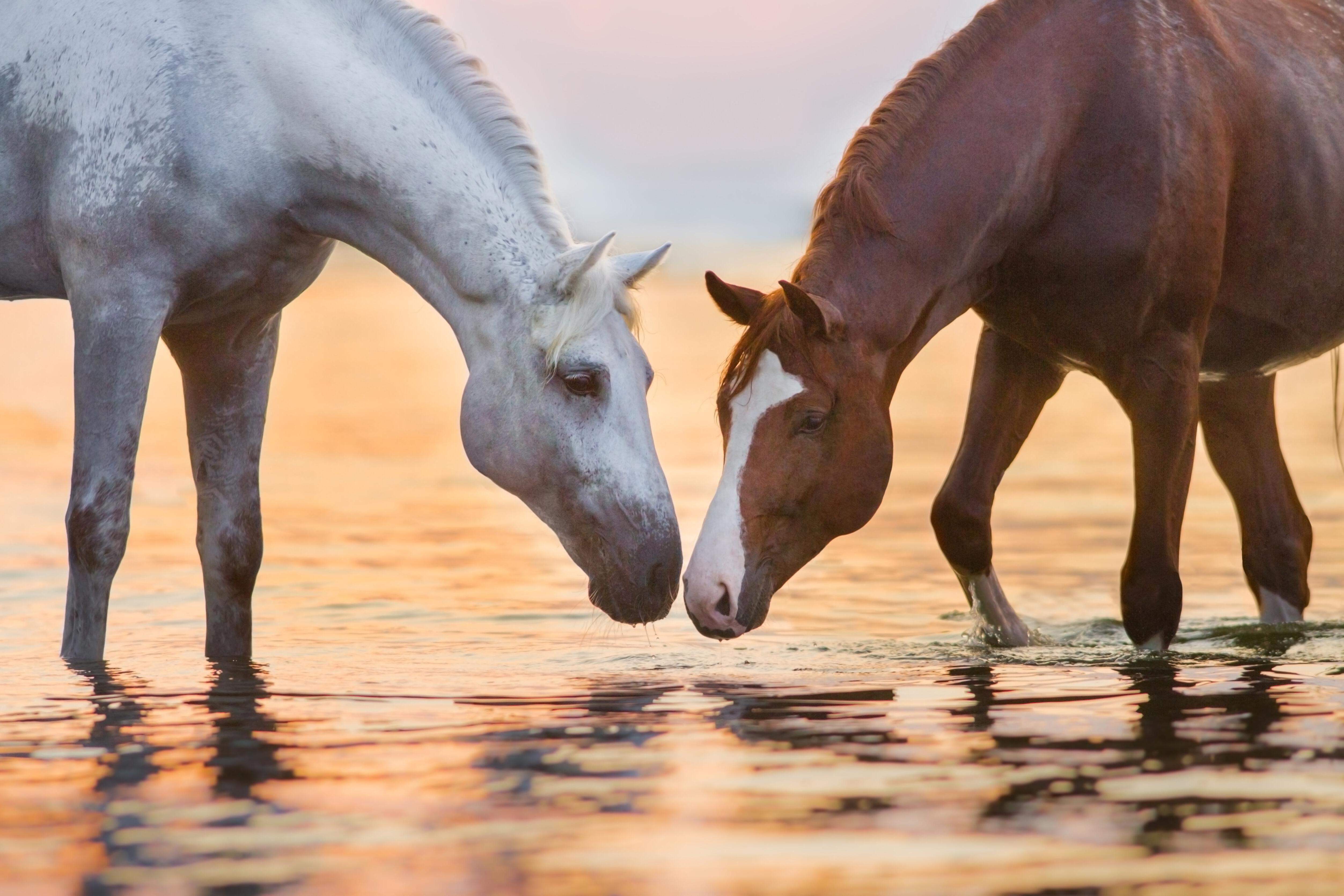
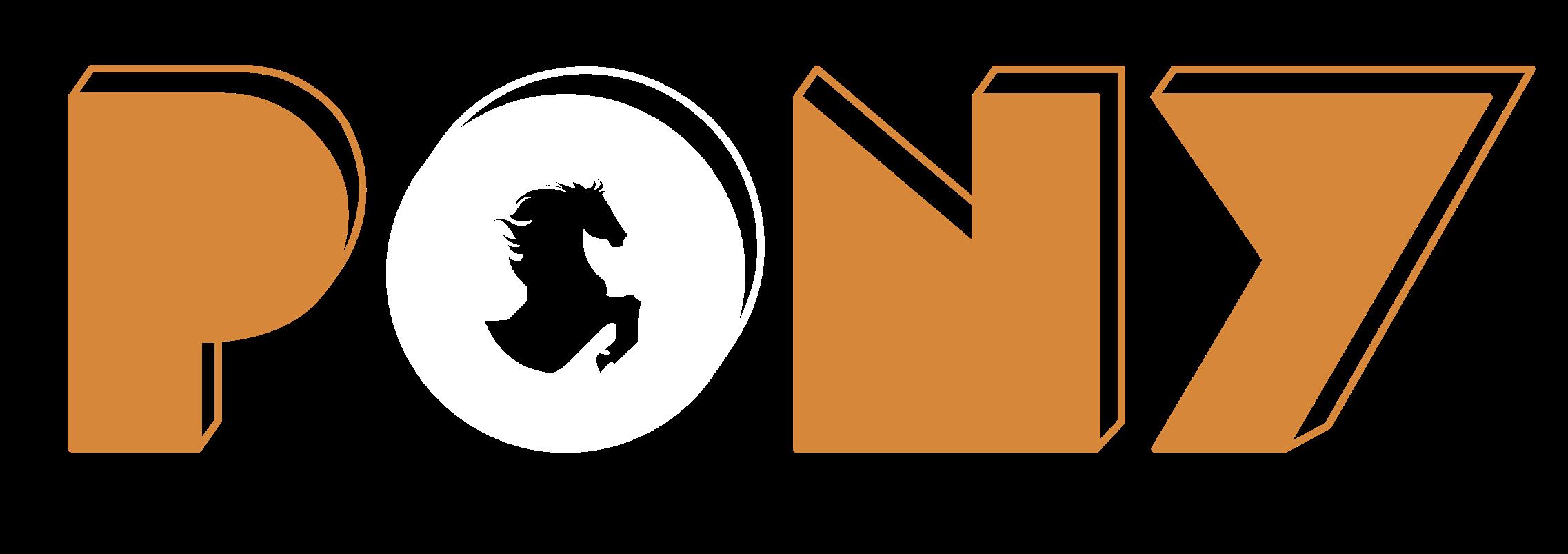
EDITION 27 | AUGUST 2023
MEET RAZZLE & DAZZLE
Razzle (black and white piebald) and Dazzle (brown and white skewbald) have gorgeous fluffy feathers and a plaitable mane and tail. Their coats are super soft – perfect for brushing and snuggling into!

The ponies stand securely on all four legs and are flexible, making them safe for young children (3 years +) to play with. Each comes in their own posh horse box that turns inside out to become a luxury stable!
LIMITED STOCK. Contact your nearest Western Shoppe branch to order.

www.westernshoppe.com
Welcome back to another issue of HQ Pony Magazine!
After our special edition last month, this edition sees us catching up on content from the past two months.
We have interviews with Jenna Odell, who rode Callaho Liberty Lord Cassini in his first-ever Grand Prix and achieved a magnificent win, and Ryan Wallbridge, who is currently following his equestrian dreams over in the UK. We also chatted to young rider Jamie Alexander about her recent trip to Europe with Michel Van Eck Sporthorses, where she was fortunate enough to watch Harrie Smolders win the Longines Grand Prix on the special stallion Uricas vd Kattevennen.
We then continue our Groundwork Series with a look at the hindquarter yield and have our usual features of puzzles and Q&A.
As always, we would love to hear from you regarding what you’d like to see in the magazine. Drop us a message on Instagram or Facebook if there’s anything you’d particularly like us to feature, and we’ll do our best to get the info together for an upcoming issue.
Until next time, happy riding!
GET IN TOUCH
We’d love to hear from you and receive your photos, drawings or pony-related thoughts. To get in touch send an email to lizzie@hqmagazine.co.za and we’ll get back to you!
3
Lizzie and the HQ Pony Team
welcome

4 CONTENTS A quick catch-up With Jamie Alexander Ryan Wallbridge Passion and determination will go the distance Callaho Liberty Lord Cassini and Jenna Odell Winners of the Shongweni Grand Prix Groundwork Part 5 Yield the hindquarters with a direct feel Puzzle fun Q&A Products we love 06 14 26 36 40 42 44

Horse and rider

A quick catch-up
With Jamie Alexander
HQP caught up with Jamie Alexander to find out what she got up to on her trip to Europe with Michel Van Eck Sporthorses.

HQP: Where in Europe did you go?
Jamie: We went to Germany and the Netherlands. We were based at and training at Terhoeven-Urselmans Horses (stables) in Germany.
HQP: What did you do while there?
Jamie: We had two lessons a day on different horses; lessons from Michel Van Eck of Van Eck Sportorses and Kai Terhoeven-Urselmans. We went to watch four shows, including the Longines Global Champions Tour at Riesenbeck. We competed in a small show in Holland. We shopped at Emmers Equestrian, went for dinners in the neighbourhood towns, had a theory lesson and went to a music festival in the Netherlands.

6
Horse and rider


Horse and rider
HQP: How did you find the overall experience?
Jamie: I loved every minute of it; the shows are extremely well run and have an overall calm environment. Michel is an exceptional coach whose training style dovetails perfectly with my coach at home (Ronnie Healy).

Our German instructor was also excellent, and it was great to get an international point of view on our riding.

8
Horse and rider
HQP: Can you tell us a bit about the horses you got to ride?

Jamie: The horses were lovely. Very different to my horses at home as most of them were very tall with lots of blood. Champ is the horse I rode most and rode at the show; he was a real gentleman with a flashy jump. He is by the stallion London and out of a Chacco Blue mare; he is a nine-year-old gelding. We got on very well from the start, and I thoroughly enjoyed being paired with him. I also rode two mares and another gelding, all with quality bloodlines; they were all very different, but all had a lot of blood.

9
Horse and rider
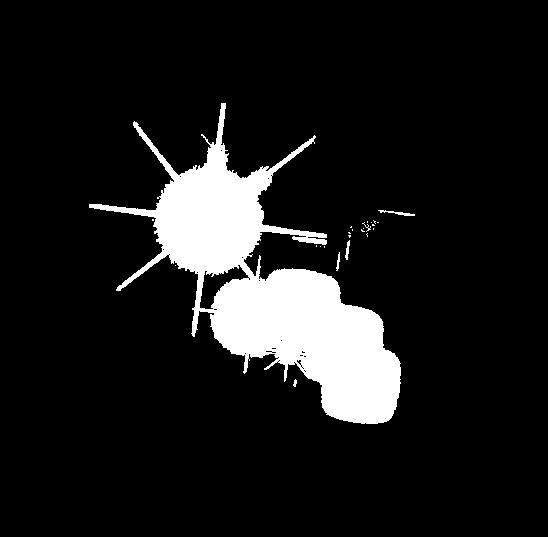

HQP: How did you find the experience in Europe compared to back home?
Jamie: The Germans are very systematic, and the horses are in a strict routine. The shows are extremely well organised, attended by lots of people and have a festive atmosphere. The warm-up arenas are much calmer than South Africa's warm-ups. There are far more grass arenas. The Europeans were true horsemen - very involved in the horses' day-to-day care. Many South Africans only really focus on the riding part.

10
HQP: Do you have future ambitions of going back?


Jamie: Yes, as soon as possible. I just need to win the lottery. I'd love to attend more clinics and possibly even work at a yard in Europe.
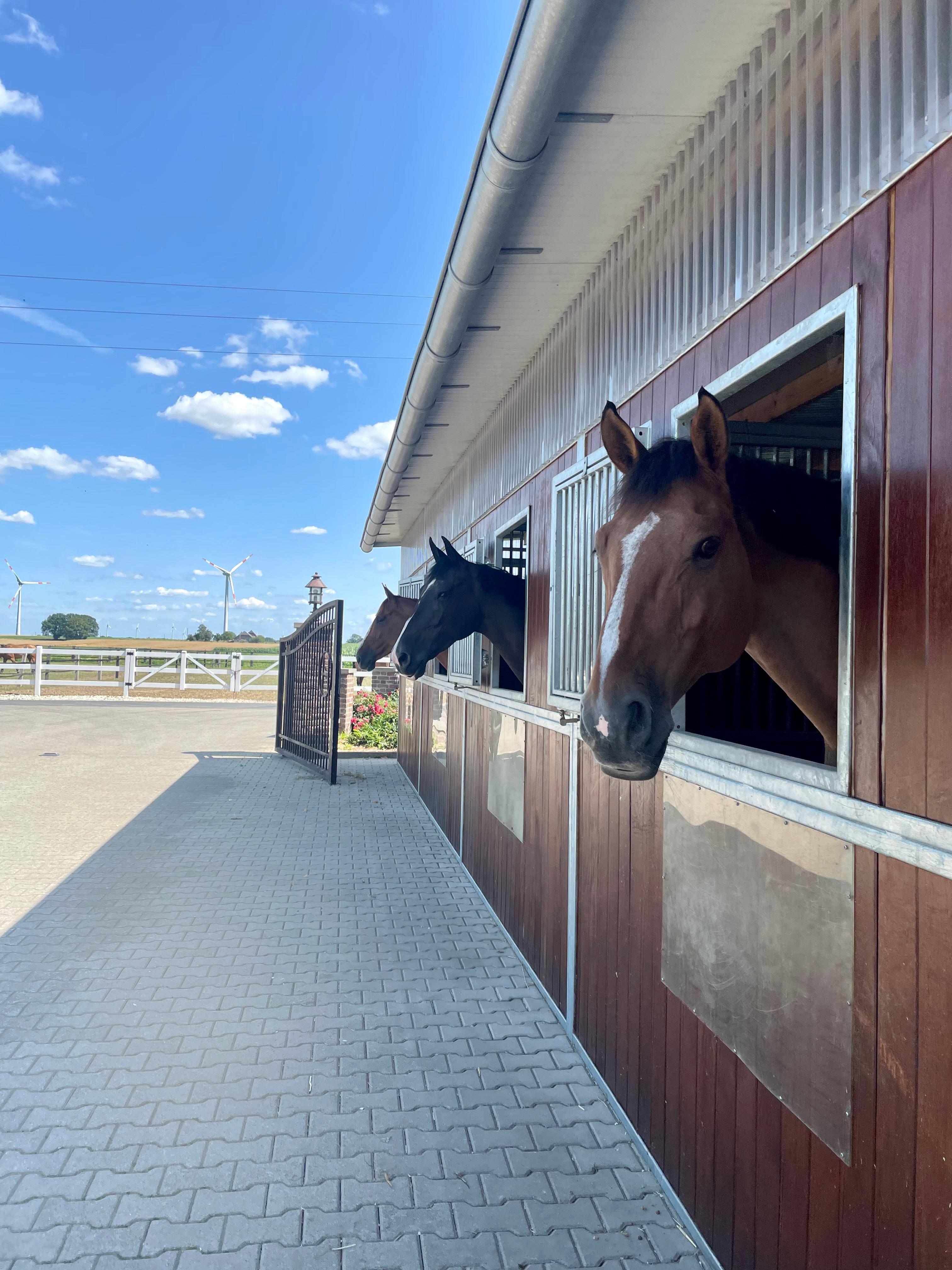
11
Horse and rider
Horse and rider
HQP: What was a moment that stood out?

Jamie: Watching Harrie Smolders and Uricas vd Kattevennen in their jump-off at the Longines Global Champions Tour was the most incredible thing I have ever witnessed. It was so cleverly ridden, and the stallion was magnificent.

12
Stokkiesdraai World Cup Qualifier
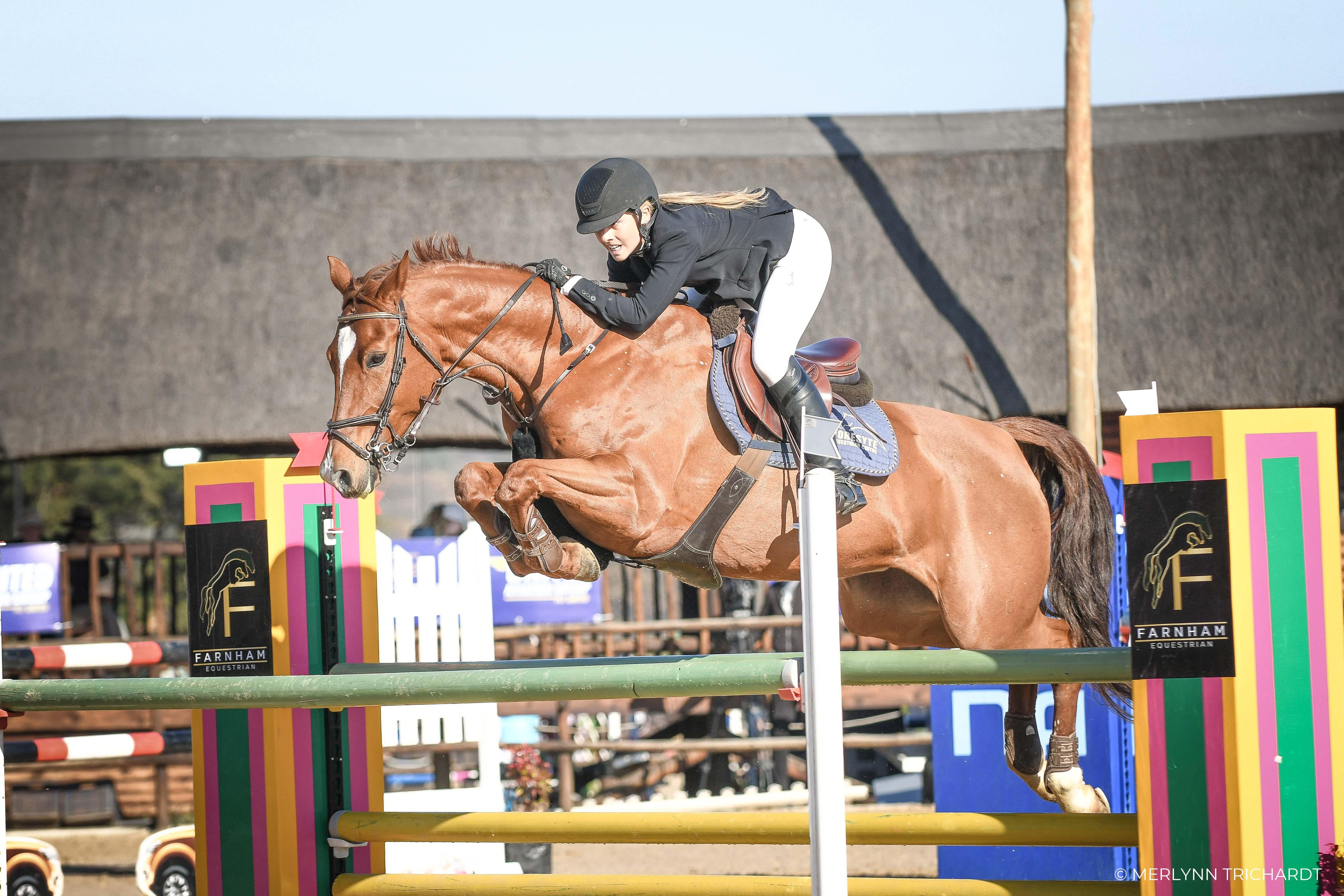 Photography: Merlynn Trichardt Photography
Photography: Merlynn Trichardt Photography
Ryan Wallbridge
Passion and determination will go the distance
It has been said that people with great passion and determination can make the impossible happen. This is the sentiment that comes to mind having spoken to Zimbabwean born and bred showjumper Ryan Wallbridge. Ryan spent several years working under Grant Langley in KZN and recently hopped across the pond to gain some international experience. We had the chance to catch up with him and find out how it is all going!

14
Horse and rider
Text | Amelia Campbell Horne Photography: Various
Horse and rider

15
Horse and rider

HQP: Can you tell us a bit about yourself?
Ryan: I am a born and bred Zimbabwean who lived in Harare for the first 18 years of my life. I was introduced to riding by my Granny, Lesley Wallbridge, who had an incredible love for animals but more especially for horses. This love of hers transferred to me, and I never realised then that it would become as important to me as it has.
Before I could walk, I was riding and spent most of my weekends at Granny’s, horse shows or riding in some way or other. I was lucky to have abundant opportunities, amazing instructors, and the support of my family to pursue my riding. Sadly, when my Granny died, there were a few changes that happened, and for a brief period, I left riding. However, there was always a longing in me to return to where I had been the happiest.
16
HQP: We’re sure most Zimbabweans will have fond memories of Granny Wallbridge arriving at horse shows with a multitude of ponies for her grandsons to ride and of course, her sound advice to the boys, like “Don’t cry in front of the ponies, it will upset them!”. So, how did you get back into riding after your Granny?
Ryan: After just over a year of not riding, I realised that there was a part of me that still yearned to be with horses. I started enquiring and was lucky enough to be given the opportunity by Riven Stud, who had numerous horses they had bred that needed producing. Fortunately, at that time, I lived reasonably close to their yard and was able to ride there as often as my school schedule would allow. It was there that I started to gain a deeper knowledge and understanding of young stock: how to back them and how to ride all sorts of different horses with their own characteristics and traits. I realise now that this knowledge was fundamental to helping me become who I am today. From this experience, I developed an interest in breeding and the art of finding the best mix. I would spend hours on my phone reading up on who was who in the world and trying to find what I thought the best mix would be!

17 Horse and rider
Horse and rider
HQP: Wow, so your interest was allencompassing! How did you end up in South Africa from there?
Ryan: After school, I left Zimbabwe to join my mum in Durban, where I was blessed to be introduced to Grant Langley. It was from this moment that my hobby started to turn into a career, and I began to understand the workings and expertise needed to run a successful yard. My growth in maturity, stable management, horsemanship, and experience took an exponential leap, and I realised that there was so much to learn. I also realised then that I needed to figure out how I could make this my life’s career. Grant was and still is a huge inspiration to me, without whom I would never have been where I am. His input into my life has been invaluable, and I owe him so much.

HQP: That is incredible. Can you tell us a bit more about your time working for Grant Langley?
Ryan: My time at the Langley Equestrian and Foresyte Stud was both enjoyable and hard work. I loved what I was doing and learned an incredible amount. Working for Grant Langley was an amazing opportunity and one that kickstarted my riding career. Grant was a remarkable mentor. He is a true sportsman whose drive, ethics, as well as riding and teaching ability gave me the perfect platform to learn from. He has played a significant role in both my professional and personal life and for that I owe him hugely.
When I arrived at the yard, I immediately fell in love with the horses that I was given to school and struggled to give them up or change to take on others. However, by having to do so, I had the opportunity to work with a large variety of horses and their different personalities. This was just one of the positives from working at the yard.
My time at Langley also primarily consisted of being instructed by Grant. In doing so, I have developed considerably as a rider, teacher, and person. Through Grant’s instruction, I have achieved so much in my riding career as well as gained the confidence to teach others. I found that I share a great passion for teaching others and did so at all levels. I was able to develop an understanding and sense of when something was not right and why that was so.
18

19
Horse and rider
HQP: So, you’ve added another dimension to your passion for horses, coaching!

Ryan: Yes, but my fondness for breeding also grew during my time there. One of my greatest memories is spending hours with Grant going through lists of possible semen donors, debating the potential and attributes. I still find myself excited to sift through the network of breeding sites to look for the ‘’One’’. To harness this passion, Grant secured a young horse Jupiter De Martelinville and allowed me to be a partner in raising and breaking him in. I instantly fell in love with Jupiter and spent much time teaching him. Jupiter and I even had a chance to jump our first 1.50m Grand Prix. Since then, I have trained many foals who are now competing or have competed at the high levels. Of this, I am very proud.
Grant’s yard is largely focused on hard work and results, but that is not to say that we didn’t always laugh, harness friendships, and have downtime. I built many relationships through the yard and will always keep them close to my heart. I learnt an enormous amount at the yard to equip me with the confidence and knowledge needed to be a great horse rider and for that, I thank Grant.
20
HQP: How did you end up in the UK from there?
Ryan: Now that I knew that working with horses was what I wanted to do, I needed to find a way to enjoy horses but at the same time make a living out of it. So, I decided I needed to get more exposure and see how the other half of the world worked and how I could improve myself and make a career out of what I loved. As I had a UK passport, the easiest choice was to move there which is where I find myself today.
HQP: The leap across the pond is a big one! How did you figure out where to go?
Ryan: I have been working at a horse farm called Oakingham Stud in Goring on Thames for just over six months. It’s been an incredible experience and a real eye-opener learning a completely different lifestyle.

and rider
Horse
Horse and rider

HQP: What does a day in the life of someone working in the UK look like?
Ryan: As I am now officially employed as a groom/rider, an average day of mine, depending on the weather, starts at 7am. The days are incredibly physical, and I must admit it took me a while to get used to. To start with, I muck out six stables (wow I miss my grooms), which I can usually finish around 9am. I have a quick 15 min tea break and then get on with my riding, which can be anything from eight to nine horses. I have a 45-minute lunch break, which I often miss, and then I crack on and finish up with the remaining horses. Once completed, I get stuck into cleaning the main tack room and the wash bay. All grooms are assigned yard jobs to do, and mine is to keep the main tack room clean and one of the wash bays. I am fastidious about this, so it does take me a bit of time. It’s a standard six-day week for me, with a Sunday off every week unless it’s my weekend to work on the Sunday.
All being well, I try to finish this up around 4:30pm. Now I need to clean the stables again before feeding the horses at around 5:30pm. Once fed, I sweep the yard and make sure the yard is tidy, the stables are clean, and the horses are blanketed. Generally, this takes me up to 6:30ish if I am lucky.
During the summer, it changes a little as some of my horses get to go out into the paddocks during the day, so this allows me to start riding at 7am instead of starting with mucking out stables. The number of horses I ride increases to 10 or 11 a day, plus I like to keep the yard lawns mowed, so once a week, I hop onto the lawn mower and enjoy the peacefulness of the mow. The grounds are beautiful but very big, so this job takes quite a bit of time, but it is something I really enjoy.
There are a fair number of competitions to attend, which does change the yard into a hive of activity to try to get as much organised the day before as possible, and for those who stay on the property, the day of the show starts extra early. I organise the trucks to be packed and loaded with all the tack etc, ready for an early start. As the shows are a few hours away, our time management is crucial. Before leaving, stables must still be cleaned, and each horse must be turned out accordingly.
22
Horse and rider

23
HQP: And what are your five top tips for people wanting to experience equestrianism on the other side of the world?

Ryan: So, based on my experience, my advice to young riders or riders wanting to travel abroad would be to remember that the grass is not always greener on the other side; it’s hard work and long hours here in Europe. The saying, “hard work with blood, sweat and tears”, is basically how it goes. I think anyone embarking on this route needs to be very sure about where they are going and what they want to accomplish. They need to be ready to do everything on their own with very little guidance and keep their focus on why they are there. Ideally, one hopes to find a yard that has competition horses that the owner is willing to let you show so that you can grow and climb the ranks. This is not always easy to find. But if you do go for it, just make sure you don’t give up when it gets tough.
HQP: Thank you so much for taking the time to inspire us with how passionate you are about all things equine! We can’t wait to see where you go from here, but we are sure there are big things yet to come!
24
Horse and rider

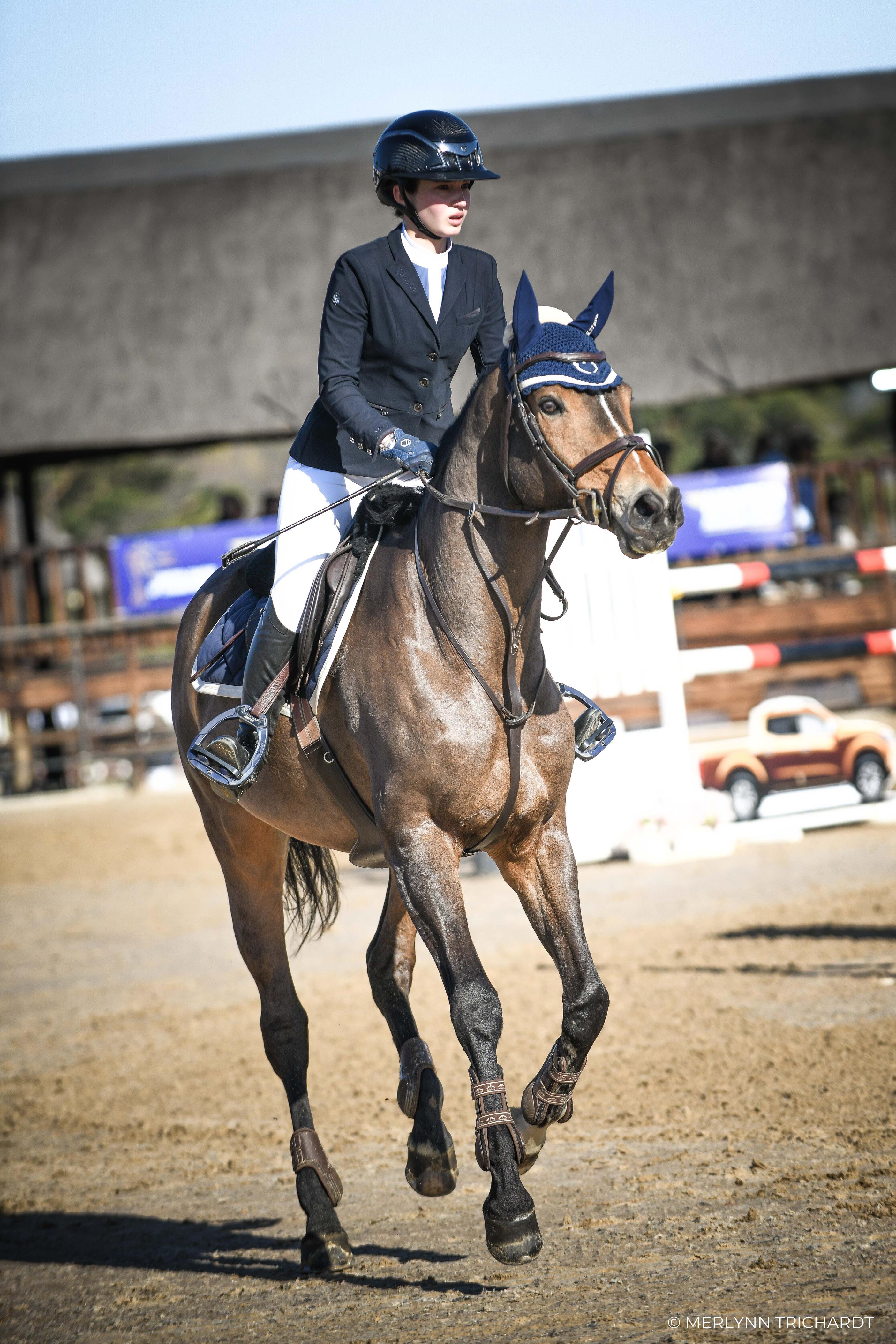

Callaho Liberty Lord Cassini and Jenna Odell
Winners of the Shongweni Grand Prix
When Jenna Odell came into the ring on Callaho Liberty Lord Cassini for his first-ever Grand Prix in Shongweni earlier this year, it was clear we were watching a special partnership. Not only did these two jump a clear on a challenging track that had many of the experienced horses struggling to find their feet, but they went on to put in an exceptionally assured jump-off performance and win the class.
We caught up with Jenna to learn more about her and her inspiring equestrian journey.
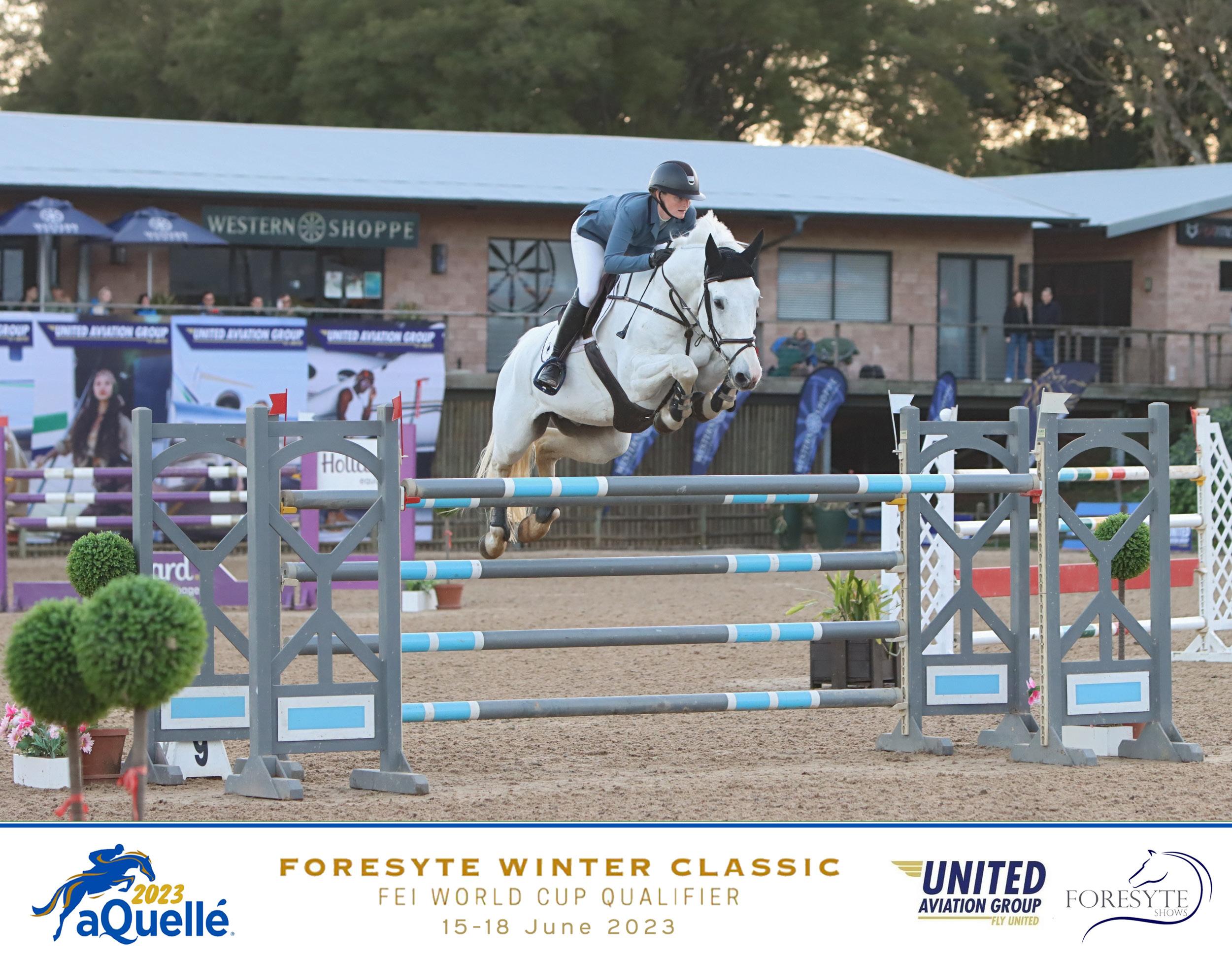
26
Photography: Denford Studios
HQP: Tell us a bit about your riding career. How did it all start?

Jenna: I started riding when I was about seven years old. I have no idea where the drive to ride came from, as none of my family were involved with horses at all! After months of begging them to take me for some lessons, I started having weekly riding lessons at our local riding school. I don't think my parents realised then what they had started!
Horse and rider

Horse and rider
From there, we slowly started developing. I didn't feature much in ponies, or in juniors, for that matter. I had green horses that I had to school up myself, and when I reached matric, I finally had a really nice string of self-produced 1.30m horses and I started to be a bit more competitive.
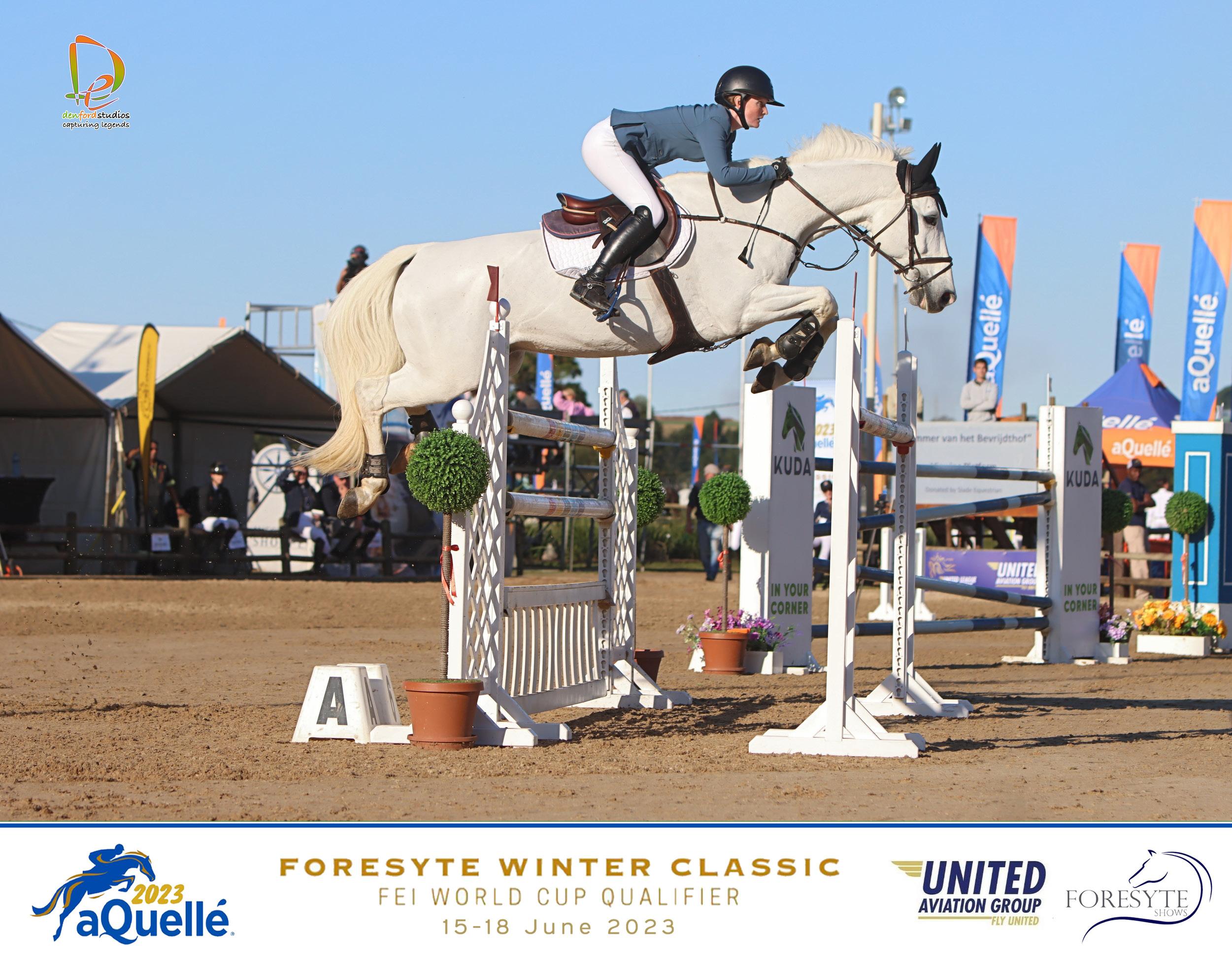
After school, I studied online so I could keep competing and moving up the grades. I jumped my first Grand Prix shortly after leaving school and slowly moved into the World Cups with my lovely Parc Pleasure. I've been in and out of the World Cup classes since then with two horses, Parc Pleasure and Figo. Parc Pleasure is now a happy old man retired at home with me, and Figo, unfortunately, had a bad injury, which has left him retired with me as well.
I'm hoping Lord Cassini will be my next horse to jump up in the World Cups with!

28
HQP: Tell us a bit about Liberty Lord Cassini.
Jenna: Lord Cassini was bred by Callaho Stud, and we bought him off the 2016 auction as a green, VERY naughty four-year-old. He is a Lord Z x Cassini I x Caletto gelding. He has been an extremely slow production - he is very quirky and difficult at times.
There were many times when giving up looked like the best route to take as he is a very sensitive, blood horse which comes with its challenges, yet is also what makes him an exceptional sporthorse.
But, as tricky as he can be, he is incredibly brave, electric and as careful as they come, and he gives me 100% every time we go into the ring!
In the barn, it's like butter wouldn't melt in his mouth! He is super sweet and affectionate, a perfect gentleman!
Horse and rider
HQP: Who is your coach?
Jenna: I started riding with Gonda Betrix when I was 16, and she has helped me immensely since then! Unfortunately, she doesn't travel to us in KZN anymore, but I still get a few tips and tricks when we're at the shows if I run into a problem.

For the last four years or so, Chad Cunningham has been helping me. He and Gonda have worked closely together, so it has been such a nice transition within the same 'system'. Chad comes down to us for lessons every three months or so.
Then, my horses have been having weekly flatwork lessons with Sacha Roberts as well, and this has been a huge part of keeping my horses my horses fit, supple and feeling well in their bodies.
29
Horse and rider
HQP: Talk to us about this Grand Prix.
Jenna: This was actually Paddy's first Grand Prix! We have been building him up quite slowly this year after he had a bit of time off last year. At the beginning of this year, my goal was to have him fit and strong enough to jump the Shongweni Grand Prix if I felt he was up for it. In the weeks leading up to the show, and with all the prep we had done this year, I knew he was ready. He was feeling better and stronger than ever, and I felt it was the perfect time to give the Grand Prix a go.
I must say, when I walked the track, I thought it was quite an ask for him, and I would have been really chuffed to come out with 1 or 2 down! From the minute I got on him, he felt amazing, which is saying a lot as he can be very difficult in the warm-up! I was also SO nervous for this class, something very new for me as I don't usually feel the nerves at all!
I so badly wanted it to go well for Paddy as well as myself, knowing that I had produced him myself right from the beginning.
When I went over that first fence, I knew I had nothing to worry about. I think he realised it was a big occasion, and he definitely rose to it. He jumped around that track as if he'd been doing it his whole life - he felt the best he's ever felt. I was very teary when I came out of the ring with a clear round. He is naturally a very quick horse who likes to run and jump, and our plan for the jump-off was to use that to our advantage and have a quick clear. Again he gave me absolutely everything he had when he went into the ring and came home with the win! It was definitely not expected, that's for sure, but it was a win that meant so much looking back at where we started!

30

Horse and rider
HQP: And - unrelated to your win - what happened with the broken bit on your gorgeous Thoroughbred? You did unbelievably well to control that so well! [For those who didn't see this, Jenna's bit broke just before the last fence in one of the earlier classes of the same day.]

Jenna: Ah, what a pity! My lovely TB Finding Troy was cantering clear to the last fence, and the bit snapped clean in half, leaving me with no controls. When I realised, I grabbed his martingale and gently pulled back, and he slowly came back to the walk and stopped in the corner for me - he is such a sweet boy!
HQP: Tell us about your current string of horses.
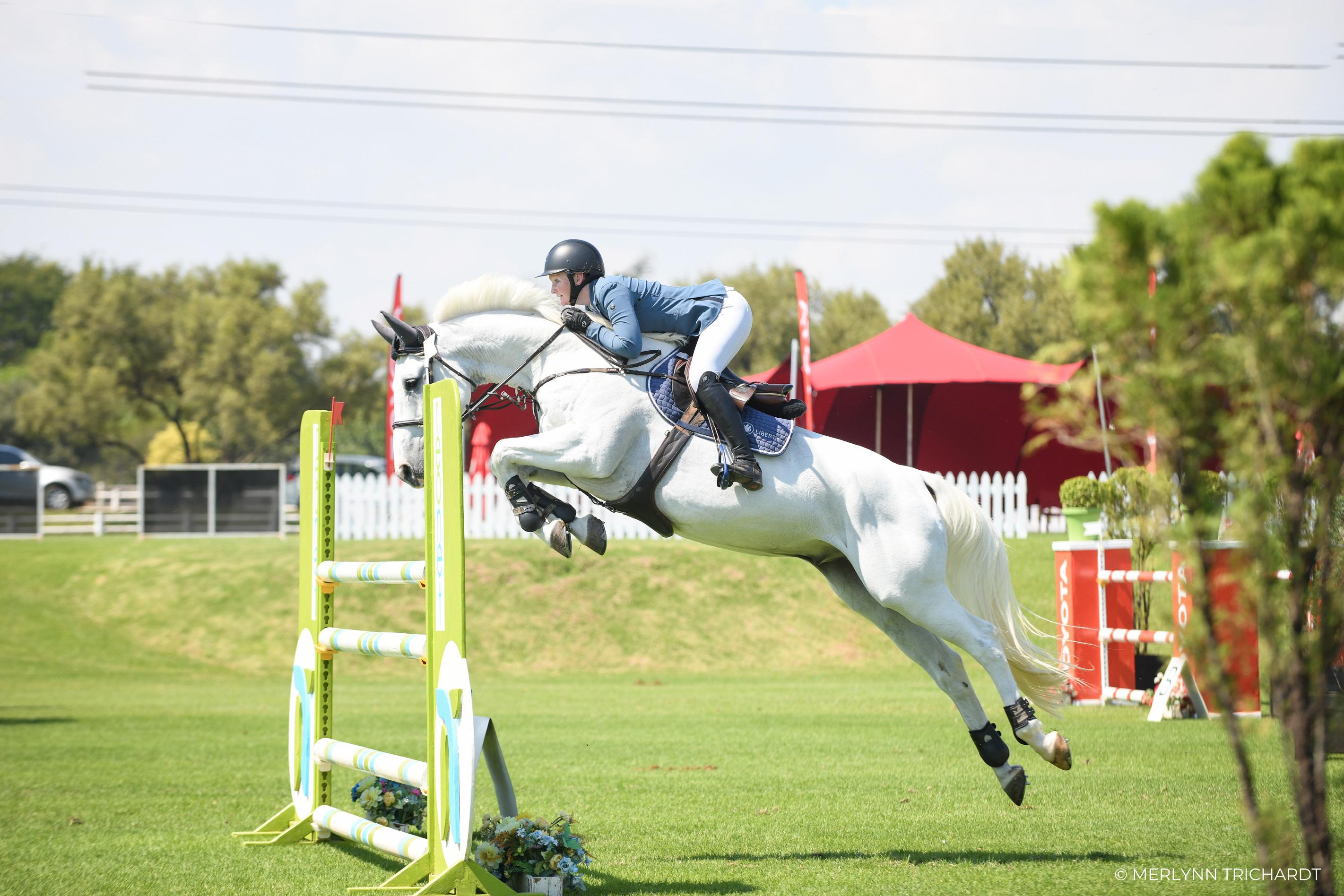
Jenna: I have four horses of my own currently, including Lord Cassini, who we've spoken about already.
Finding Troy is a lovely Thoroughbred that I've produced up to the 1.30ms. I have absolutely loved producing him. Compared to the Warmbloods, he has been so straightforward and easy; he's just a really nice person! I've had him for two and a half years now - I actually went to ride him for his previous owner as she wanted to sell him. The minute I popped him into the canter knew I wanted to try and buy him for myself. He was exceptionally balanced and had a huge, active canter for a green Thoroughbred.
The last two in my string are four-year-olds. The first is Cortes, a Consuelo gelding that we bought as a six-month-old. I backed him last year, and he's almost ready to head out to his first show. I'm really excited about him - he's a big boy standing at 17.1hh already, and he can be a bit nervous and suspicious of things, but I've been taking my time with him, and I think he's going to be something special!
My final one is Callaho Roma Elektra (Cartier x Escudo), who we recently purchased off the Callaho Auction. She has been having a nice break at the Stud, so she hasn't arrived home with me yet, but I'm so excited for her as well! I loved her from her first free jump video and loved her just as much when I sat on her. I'm very excited to get started with her.
32
HQP: Tell us about a normal day for you.
Jenna: I try to work my own horses first each day, so I have the time I need to put into each of them. Sometimes that means very early starts! Once mine are worked, I generally ride horses for owners if they need working, and then I go into lessons for the rest of the day. My horses' schedules are stricter and specific for each of them. The older horses work four days in the school doing lots of flatwork, poles and cavalettis, and normally one jump school, and then they hack out twice a week doing track work and some hill work as well. We are so lucky to have lots of space to do this! The young horses usually only work in the school two, max three days a week, and then they do lots of hacking as well to keep their brains fresh.
Horse and rider
HQP: What are the greatest achievements of your riding career to date?

Jenna: The Shongweni Grand Prix was definitely the biggest win in my career for sure! Second to that was probably winning the South African Young Rider Championships in 2020 on Paddy as well.
HQP: What are your goals for the future?
Jenna: My goals for the rest of this year are, hopefully, to jump the last World Cup at Hartland with Paddy and to continue developing my younger horses and get them out to a few small shows. Long term, I would love to keep producing a nice string of young horses up the grades. I love producing the young horses; it is such a rewarding process, especially when you get one or two really special ones!
33
Horse and rider
HQP: Who are your heroes in the sportboth here and overseas?
Jenna: Two lady riders that I've always looked up to are Beezie Madden and Laura Kraut. These women are exceptional riders and athletes; I learn so much by watching them. McLain Ward and Marcus Ehning are another two that I always love watching and following!

HQP: If you were to give some advice to young riders about the best ways to succeed in our sport, what would you tell them?
Jenna: Never give up! Determination and persistence are so important. Quietly plugging away at things and getting a little bit better each day eventually adds up. Slow and steady wins the race…
34

5
GROUNDWORK Part

YIELD THE HINDQUARTERS WITH A DIRECT FEEL
Over the past few months, we’ve received an increasing number of questions about getting started with groundwork. Whilst we advise that an instructor helps you to get started, there are a few basics that you can teach at home that ultimately form the foundation of all groundwork activities. Over the following few issues, we will look at these basic building blocks of your groundwork toolbox and help you to build a solid foundation for your in-hand work.
This issue, we look at one of the most useful exercises for moving your horse around, the hindquarter yield. This exercise is also vital for your future lateral work, as it teaches your horse to yield his hindquarters from your leg.

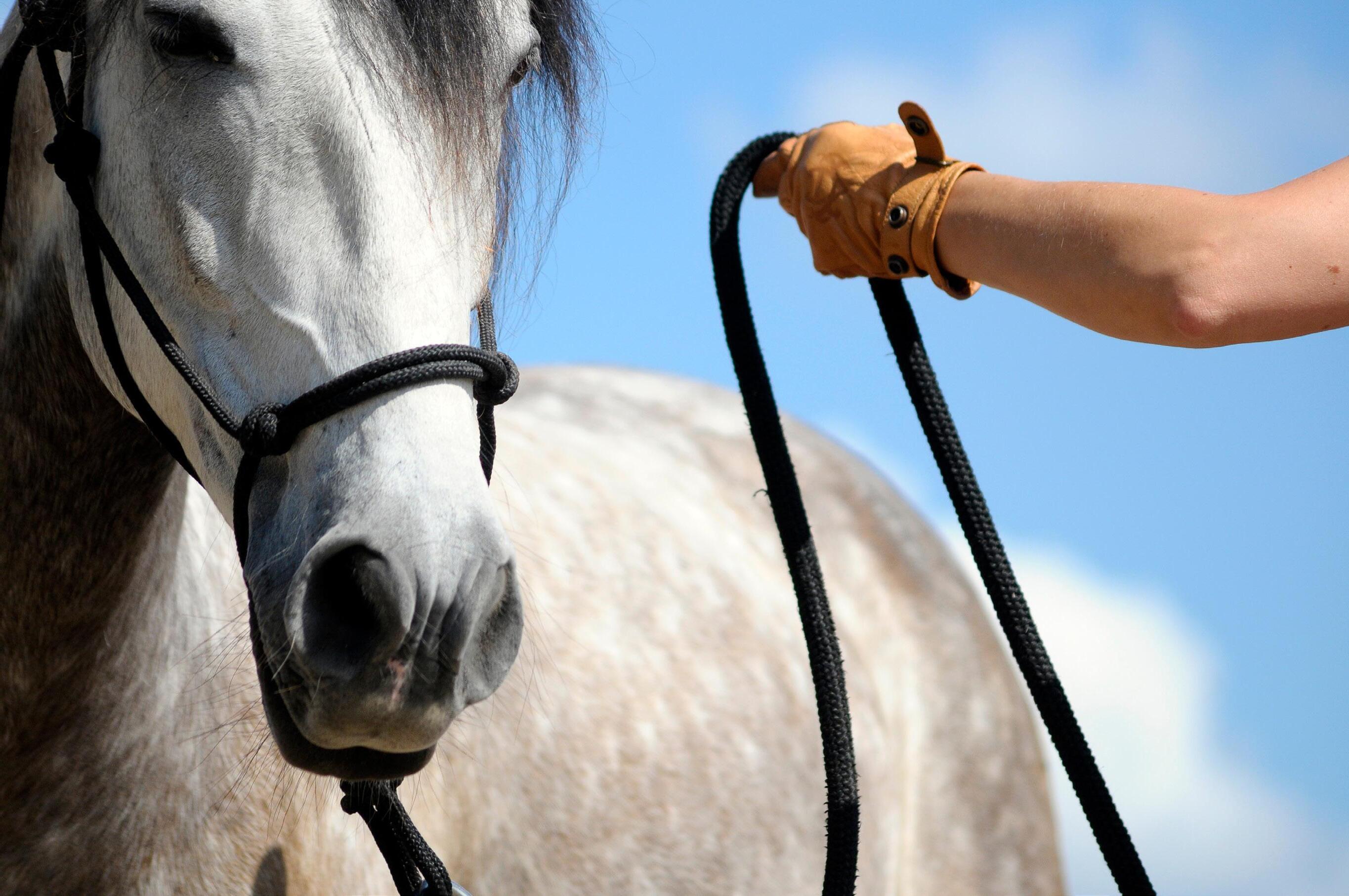
36
YIELD THE HINDQUARTERS WITH A DIRECT FEEL
In this exercise, you will need to ask your horse to step away from you while keeping his body softly flexed around you and his front legs relatively still.

How to do the exercise
Stand at your horse’s rib cage and ask him to bend his head and neck towards you (lateral flexion) without moving his feet.
Then adjust your position so you are standing by his hindquarters facing ‘through’ his hindquarters. A helpful way to think of this can be to think of his body as a gate that you will open and walk through as it pivots on the hinge (the forequarters). Keep a feel on the line to maintain the lateral flexion, but not pull him around. Then, lift your energy,

37 Horse and rider
Horse and rider
Once he understands the idea and moves from a light feel, you can move your feet, walking in an arc so that he softly yields his hindquarters around a few steps. You can gradually build this up to a complete turn.
Practise from both sides and aim to reach the stage where he can walk around his inside foreleg as he lifts and replaces it more or less in the same spot.

Points to note

When starting out, just ask for one step. As soon as he takes that one step, release. Don’t lean on him or push him, as you will just encourage him to push back into you.
During the exercise, the inside foreleg should remain relatively still, picking up and putting down in roughly the same place as the horse walks around this leg. You do not want your horse to pivot on the leg (i.e. spin around it without lifting it) as this is not good for the joints and instead encourages him to put all his weight on his inside shoulder.
The further he steps under with his inside hind leg, the more elastic and supple he will become.
38
Troubleshooting
If he goes forward around you, rather than stepping sideways with his hindquarters, lift your rein hand. This should lift his shoulder and change his weight to he is less inclined to move forwards.
If he falls in on his shoulder, make sure you are not pulling on the rope and try and lift the rope slightly to avoid him falling.
If he does not want you to touch him or threatens to kick – use a stick to apply light pressure to the hindquarters, as this keeps you out of his range. Once he understands that he doesn’t need to feel defensive, the kicking should stop, and you will hopefully be able to touch him with your hand.
If he swings away from you too vigorously, he is probably feeling defensive, so he is reacting rather than responding to your request. Spend some time rubbing him all over while in lateral flexion. Then ask him again once he has relaxed.
If he doesn’t move his hindquarters, apply rhythmic pressure by tapping lightly on his hindquarters rather than laying your hand there. It will probably be easiest to do this with a stick.
If he pivots around the outside foreleg, he is travelling backwards. This is probably because he feels defensive, or you are too far forwards.

How to make the exercise more difficult
Once your horse understands this exercise completely, repeat it but touching him behind the girth where your leg will be when riding. This builds the link between the commands in the groundwork and the commands under saddle.
NEXT TIME
In our next issue, we will again look at yielding the hindquarters, but this time with an indirect feel.
39 Horse and rider
PUZZLE FUN
Can you find these parts of the horse in our wordsearch?
CHESTNUT | ERGOT | FETLOCK | FROG | HOCK | HOOF | MANE | MUZZLE | NOSTRIL | PASTERN | SHOULDER | STIFLE | TAIL | TONGUE | WITHER
NOTE: Spaces and any punctuation marks have been removed

U M P E Y Z A E I O U B Z Y U N A E R S B A I P P E T O A W N R E T S A P E O H E U A M I N U D N M I L L E D E T A V O R L T U N J N N D U F T E K C A L B E U G K T Z P O T H O M D R H D I Z N I H L A C Y Z O L S O Q Z A C B E T E R A S D N O R L C Y E C R L S H O L R D A Y A E A L P E C C H K E I G E T M A G I N U R O T A A G E C I R R B S T B A Y C U M L E E C P N M R N Z T I E E O C S S B I I C F E R I Y E G T S Y N S T I F L E C M H U E O T A V B O O M U G E P B R N O O O E D Q U N G P O N T O G R E A P A K L O S A U N R O C D N A E E R O T E O E A F T R H T E R L S K C B Y R E Y I R Y P D F K A S T F L A M A O G E B P L N A Z N O B D E A I K N I W T E L E S L U G T E R A D H I N I D C A A M E N I E L Z A T L Y O C L D N Y G I C N I A E E B O E S O V C K D O C T O N G U E M E H E G R
40
Can you spot all 10 differences?
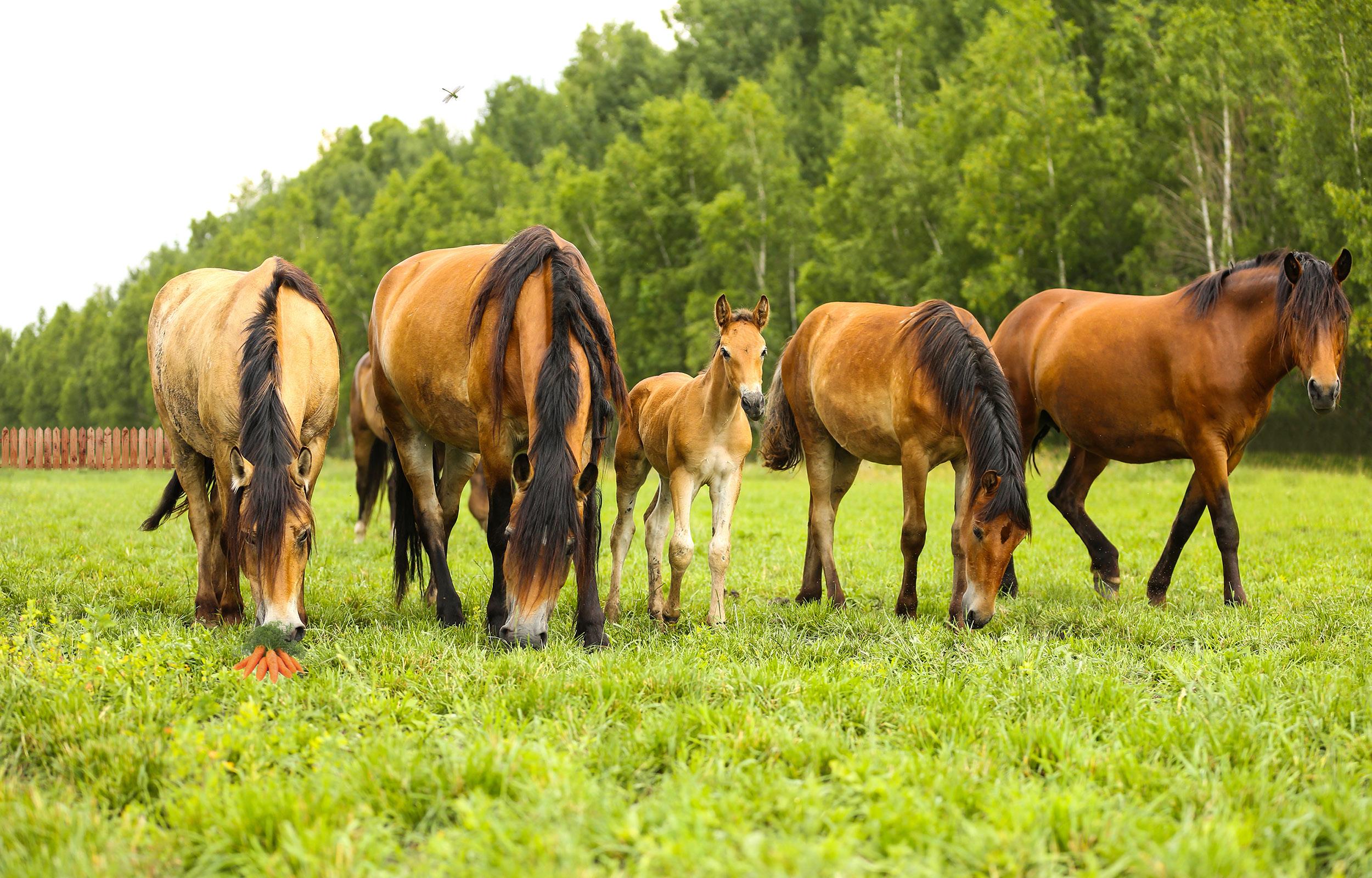
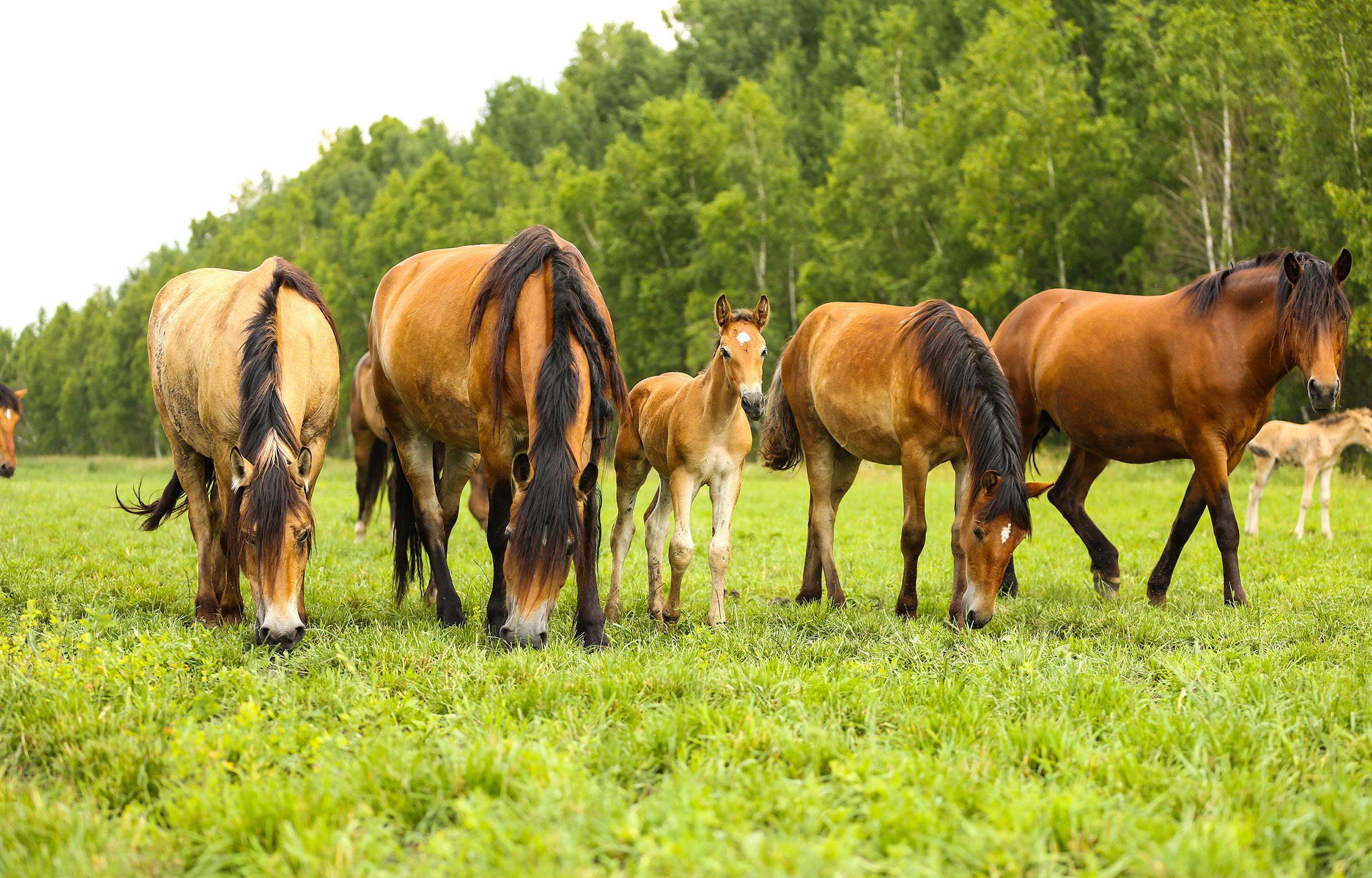
PUZZLE FUN
41
What is the Horse Grimace Scale?
The Horse Grimace Scale is a pain assessment tool that identifies six facial expressions of a horse or pony and scores them on a scale of 0 (not present), 1 (moderately present) and 2 (obviously present). The actions that are scored are:
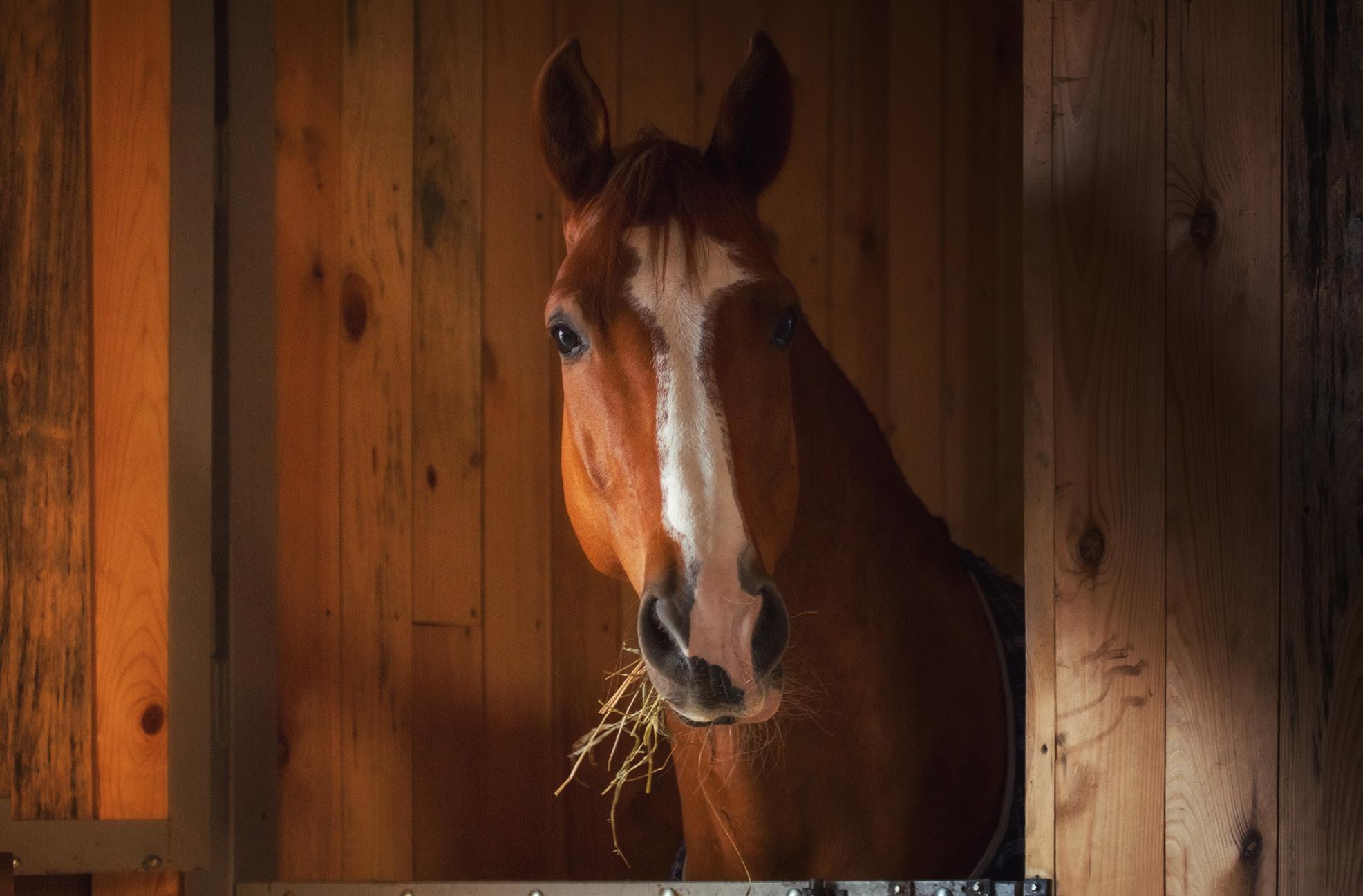
• Stiffly backwards ears – the horse or pony’s ears are held stiffly and turned backwards, causing the space between the ears to appear bigger at the top than the bottom.
• Orbital tightening – the horse or pony’s eyelid is partially or entirely closed. Any closure that reduces eye size by more than half is scored 2 (obviously present).
• Tension above the eye area – tightening of the muscles in the area above the eye causes the underlying bone to appear more prominent.
• Prominent strained chewing muscles –this is due to increased tension above the mouth.
• Mouth strained and pronounced chin –a strained mouth is present when the upper lip is drawn back, and the chin appears more obvious.
• Strained nostrils and flattening of the muzzle’s profile – the horse or pony’s nostrils look strained and slightly enlarged, and the profile of the nose flattens with longer lips.
42
Is it okay to turn my pony out in overreach boots?
It’s very common to see ponies turned out wearing overreach boots. If your pony is prone to overreach injuries or the pulling of shoes, then these boots are a straightforward way of reducing the cuts to the heels or lost shoes.
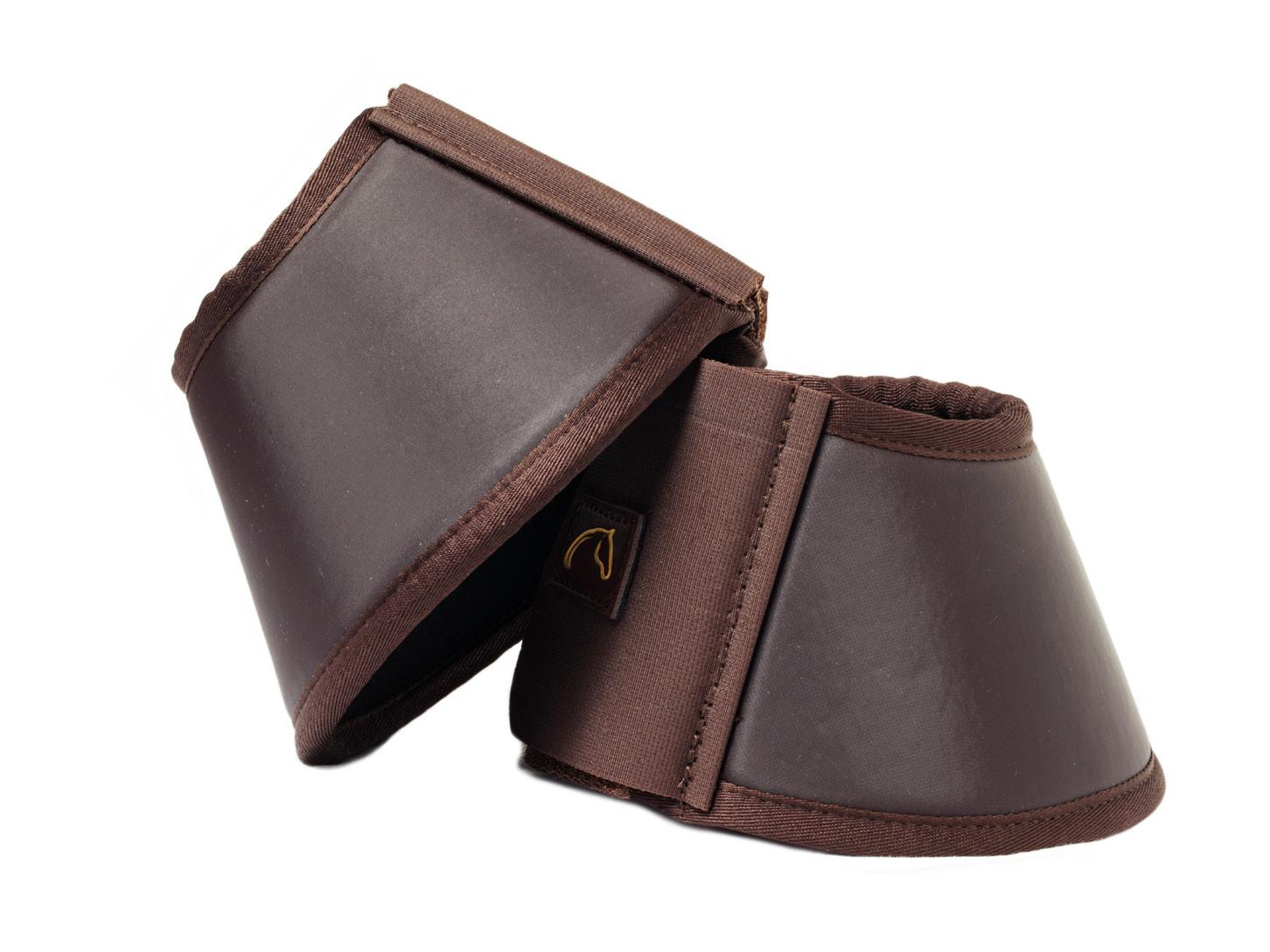
However, in order to allow your pony to be turned out in overreach boots, you must make sure that the fit is correct and that the boots will not rub him. You will also need to choose a sturdy pair with strong
What should my pony’s manure look like?
A pony’s manure can tell you a lot about his health. Manure should be made up of firm, well-formed balls. Very loose droppings or very dry droppings are always a cause for concern and should prompt a call to your vet. Ponies generally pass manure every couple of hours, so if your pony goes for a few hours without passing manure, you should again consider giving your vet a call.

It is also worth checking manure for undigested food, as this can be a sign that your pony is struggling with his digestive system in some way. It could be that his teeth need some work; that he is receiving too much food, so it is passing through too quickly to get adequately digested; that his gut is intolerant in some way to the food he is getting; or that he has a digestive issue that needs looking at.
Velcro tabs that will stay in place. All overreach boots, wherever they are worn, must be removed at least once a day for a few hours to check for any rubs or injuries and, importantly, to allow the hoof to ‘get some air’.
The other thing to look out for is visible worms. Sometimes, although rarely, worms can be visible in the manure and, in these cases, you really know that the worm burden is high and that action needs to be taken!
Basically, if you notice any change from the norm when it comes to your pony’s manure – get it checked!
43
PRODUCTS WE LOVE
Mini LeMieux Saddle Pads
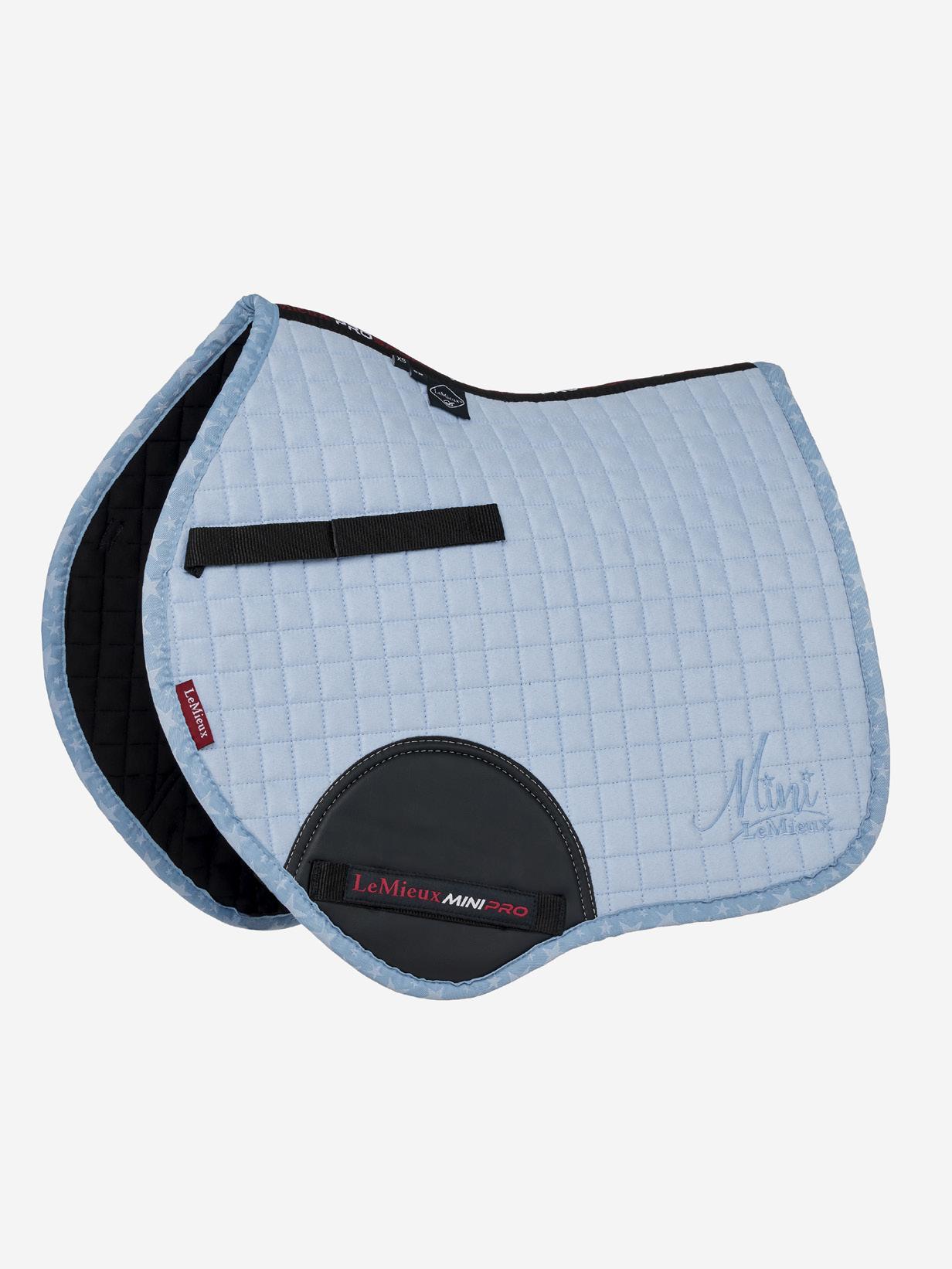
New colours for the Mini LeMieux fans!
The popular Mini LeMieux Saddle Pads are now available in new season colours – Mist, Wisteria and Kiwi. Beautiful and bright for Spring!


The Mini LeMieux’s share the same features as the main line ProSport Saddle Pads - a luxurious Suede top side, 100% Natural Bamboo lining, a high wither design, strengthened girth protection areas and girth strap locking loops. Unique to the Mini range is the super cute star pattern binding!
The Mini LeMieux collection is designed and sized for riders under 12 years with ponies sized 11.2hh to 13hh.
Shop Mini LeMieux in-store and online at Western Shoppe! www.westernshoppe.com
44
OUR NEXT EDITION OF HQ PONY MAGAZINE IS AVAILABLE
ON 5 SEPTEMBER.
SEE YOU THEN!


















 Photography: Merlynn Trichardt Photography
Photography: Merlynn Trichardt Photography




































